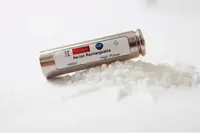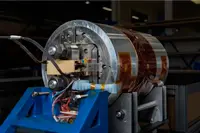Electronics News
Archive : 29 November 2015 год
 French researchers from within the RS2E network on electrochemical energy storage have developed the first battery using sodium ions in the usual "18650" format, an industry standard. The prototype batteries are claimed to have displayed performance levels comparable to their lithium counterparts, and be used to store renewable energy in the future.
French researchers from within the RS2E network on electrochemical energy storage have developed the first battery using sodium ions in the usual "18650" format, an industry standard. The prototype batteries are claimed to have displayed performance levels comparable to their lithium counterparts, and be used to store renewable energy in the future.
The idea for using sodium in batteries dates back to the 1980s. At the time, lithium was preferred to sodium as the material of choice and it has been widely used ever since for portable electronic devices such as tablets, laptops and electric vehicles. However, lithium is rare and therefore, more expensive than sodium. The RS2E researchers therefore turned towards sodium, a thousand times more abundant. They developed Na-ion battery prototypes where sodium ions move from one electrode to another in a liquid during the charge and discharge cycles.
The team was able to develop the first sodium-ion prototype in the "18650" format, a cylindrical 1.8cm diameter, 6.5cm in height - which should facilitate technology transfer to existing production units.
The energy density of the prototype batteries amounts to 90Wh/kg, a figure already comparable with the first Li-ion batteries. The maximum number of charge/discharge cycles that a battery can withstand without any significant loss of performance-exceeds 2000 cycles.
The next stage of the project is to optimise and increase the reliability of processes with a view to future commercialisation.
Author
Tom Austin-Morgan
Source: www.newelectronics.co.uk
 The CERN magnet group has set a world record with its racetrack test magnet which has produced a 16.2tesla (16.2T) peak field – nearly twice that produced by the current LHC dipoles and the highest ever for a dipole magnet of this configuration.
The CERN magnet group has set a world record with its racetrack test magnet which has produced a 16.2tesla (16.2T) peak field – nearly twice that produced by the current LHC dipoles and the highest ever for a dipole magnet of this configuration.
The Racetrack Model Coil (RMC) is one of several demonstration test magnets being built by the group to understand and develop new technologies that are vital for future accelerators.
These RMC magnets are shorter: 1 to 2m in length, compared to the 5 to 7m ones needed for the High-Luminosity Large Hadron Collider (LHC).
Juan Carlos Perez, an engineer at CERN and the project leader for the RMC, said: “The present LHC dipoles have a nominal field of 8.3T and we are designing accelerators which need magnets to produce a field of around 16T – almost twice as much.”
High-field magnets are crucial to building higher energy particle accelerators. High magnetic fields are needed to steer a beam in its orbit – in the case of dipoles - or to squeeze the beams before they collide within the experiments, which is the case for high-gradient quadrupoles.
The LHC uses niobium-titanium superconducting magnets to both bend and focus proton beams as they race around the LHC. But the RMC uses a different superconducting material, niobium-tin, which can reach much higher magnetic fields, despite its brittle nature.
The world record is a step forward in the demonstration of the technology for the High-Luminosity LHC project, and a major milestone for the Future Circular Collider design study.
"It is an excellent result, although we should not forget that this is a relatively small magnet, a technology demonstrator with no bore through the centre for the beam,” says Luca Bottura, head of CERN’s Magnet Group. “There is still a way to go before 16T magnets can be used in an accelerator."
Author
Tom Austin-Morgan
Source: www.newelectronics.co.uk
